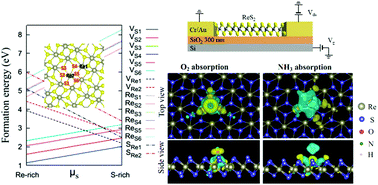Sulfur vacancy activated field effect transistors based on ReS2 nanosheets†
Abstract
Rhenium disulphide (ReS2) is a recently discovered new member of the transition metal dichalcogenides. Most impressively, it exhibits a direct bandgap from bulk to monolayer. However, the growth of ReS2 nanosheets (NSs) still remains a challenge and in turn their applications are unexplored. In this study, we successfully synthesized high-quality ReS2 NSs via chemical vapor deposition. A high-performance field effect transistor of ReS2 NSs with an on/off ratio of ∼105 was demonstrated. Through both electrical transport measurements at varying temperatures (80 K–360 K) and first-principles calculations, we find sulfur vacancies, which exist intrinsically in ReS2 NSs and significantly affect the performance of the ReS2 FET device. Furthermore, we demonstrated that sulfur vacancies can efficiently adsorb and recognize oxidizing (O2) and reducing (NH3) gases, which electronically interact with ReS2 only at defect sites. Our findings provide experimental groundwork for the synthesis of new transition metal dichalocogenides, supply guidelines for understanding the physical nature of ReS2 FETs, and offer a new route toward tailoring their electrical properties by defect engineering in the future.


 Please wait while we load your content...
Please wait while we load your content...